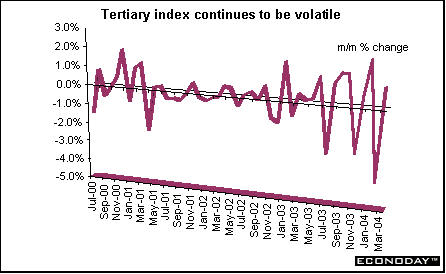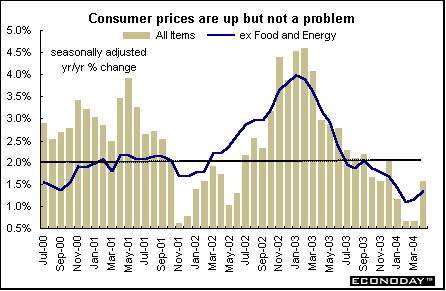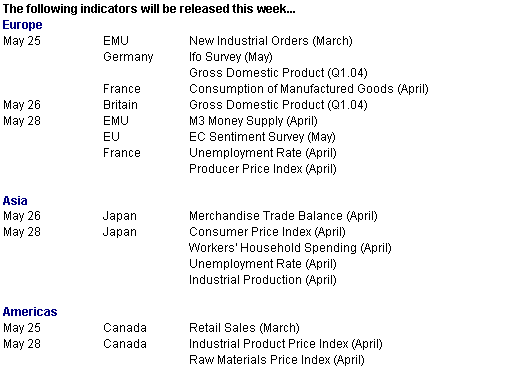Monday, May 24, 2004

Global Markets
Crude oil prices, terrorism and prospects of higher interest rates dominated investors' attention again last week. The week got off to a rocky start on Monday when all indexes followed here sank, only to revive and climb for most of the week. When markets closed on Friday, only the Dow and FTSE were down on the week.
Global Stock Market Recap

Europe and Britain
European stocks plunged on Monday as violence in Iraq and Turkey sent oil prices to a record high, adding to concerns about the global economy. Investors were worried that profit growth will slow as higher oil prices raise the costs of energy from electricity to gasoline and jet fuel. Airlines including Air France and British Airways declined. Trading in Germany and France was lighter than usual on Thursday because of national holidays in both countries. And many people extended the holiday into Friday. Indexes pared some of their declines on Thursday after U.S. initial unemployment claims were unexpectedly up and the index of leading economic indicators gained less than expected. The data eased some investors' concerns about the proximity of an interest rate increase in Europe's largest export market. But despite the volatility, the CAC and DAX managed to end the week on the plus side while the FTSE edged down slightly.

Asia/Pacific
For the second week, Asian/Pacific indexes plummeted on Monday, only to have second thoughts and end the week in positive territory. Investors here are very sensitive to oil price changes and their mood vacillated with the cost of crude. Japanese investors were heartened by better-than-expected first quarter GDP growth that showed some life on the consumer side of the equation as well. (See indicator scoreboard below.) Both the Nikkei and Topix had their second biggest declines this year. The Nikkei lost 344.58 points on Monday, dropping to its lowest since February 12th, while the broader Topix index shed 37.74 points with banks contributing most of the decline. The Nikkei has lost 9 percent since touching this year's peak on April 26th, even though companies such as Toyota and Canon have reported record earnings. Concern about potential interest rate increases in the United States and China, and higher oil prices, have weighed on exporters' stocks.

Hong Kong Hang Seng managed to end higher for the first week in six after China's central bank head said the nation will hold off raising interest rates.

Currencies
The yen had its first weekly gain in seven and advanced to a two-week high versus the dollar, as equities rose and the International Monetary Fund said Japan's economy may grow at the fastest pace in 14 years. Investors now realize that the momentum for Japanese growth is a lot stronger than anticipated and that's helped the yen to recover. A big jump in the Nikkei coupled with renewed terrorism concerns pushed the dollar lower across the board on Friday. Fears of a hard landing in China seem to be abating, and with renewed demand for Japanese equities there is renewed demand for the yen as well. Japanese stocks rose from a three-month low, spurring demand for the currency after first-quarter GDP was higher than expected. (See indicator scoreboard below.)

The euro benefited from escalating terrorism that pushed the dollar down on the week. In Europe, with many Europeans extending Thursday's Ascension Day holiday to make a long weekend, market liquidity for currencies was thin, making for wider-than-usual swings on Thursday and Friday.

The euro and British pound also reached their highest levels in two weeks against the dollar after Federal Reserve Governor Ben S. Bernanke said that inflation will probably be contained into 2005. The dollar fell against the euro after Bernanke said a "gradual" approach to raising interest rates would be enough to head off the threat of inflation. The remarks dampened speculation that Bernanke would suggest a faster pace for increasing the Fed's target rate. Speculation the central bank will boost its benchmark rate from a 45-year low in June has pushed the U.S. currency up 5.1 percent against the euro this year after it fell 17 percent in 2003.
Indicator scoreboard
EMU - March nonseasonally adjusted merchandise trade surplus jumped to �10.2 billion from �6.5 billion in February. Exports were up 15.4 percent while imports were up 12.1 percent. On a seasonally adjusted basis, the trade surplus climbed to �9.3 billion from a surplus of �7.4 billion in February with exports edging up 0.1 percent while imports dropped 2.2 percent.

April harmonized index of consumer prices was up 0.4 percent and 2.0 percent when compared with last year. Prices were higher for clothing, energy, health, transportation, hotels/restaurants and alcohol and tobacco. HICP, which excludes energy and unprocessed food, was up 0.5 percent and 2.1 percent. This is the measure preferred by the ECB. However core HICP, which excludes energy, food, alcohol and tobacco, was up 0.5 percent and 1.8 percent on the year. Six EMU countries were below the ECB's 2 percent target while six were above.

March industrial output fell 0.2 percent but was up 1 percent when compared with last year. Capital goods output was flat while all other major product categories sank.

Germany - May ZEW economic expectations index dropped to 46.4 from April's reading of 49.7. This was the fifth decline in a row. Expectations index fell as did the assessment of current economic conditions. The survey, which is conducted by the Center for European Economic Research (ZEW), tallies the sentiment on the German economic outlook among 313 financial experts. The results make clear that financial experts have increasing doubts about the sustainability of the German recovery.

April producer price index was up 0.4 percent and 0.9 percent when compared with last year. Energy prices were up 0.7 percent both on the month and on the year. Excluding energy, the PPI was up 0.3 percent and 0.9 percent. Producer prices for basic and semi-finished goods - which account for some 31 percent of the index - were up 0.9 percent and 1.5 percent on the year. This category includes many commodities whose world market prices have risen significantly recently.

France - Preliminary first-quarter gross domestic product was up 0.8 percent and 1.7 percent when compared with the first quarter of 2003. Private consumption was up 1.1 percent on the quarter while fixed investment was up 1.2 percent. Business investment was up 1.7 percent while household investment jumped by 1.3 percent.

Italy - March world merchandise trade balance rebounded from a deficit of �791 million to a surplus of �713 million. The deficit in March 2003 was �438 million. When compared with last year, exports were up 9.9 percent while imports were up 4.8 percent.
Britain - April consumer price index was up 0.4 percent and 1.2 percent when compared with last year. The index was higher thanks to household fuel and gasoline prices. The CPI is now the Bank of England's inflation gauge with an inflation target rate of 2 percent. The former target measure - the retail price index excluding mortgage interest payments - was up 0.6 percent and 2 percent on the year.

Asia
Japan - First-quarter gross domestic product jumped 1.4 percent and 4.7 percent when compared with the same quarter in 2003. Private consumption expanded 1.0 percent from the previous quarter. Consumer spending accounted for more than a third of the expansion in the first quarter, and business spending made up more than a quarter. Exports accounted for about a fifth. The GDP deflator fell 2.6 percent for the 24th consecutive drop.

March industrial output was revised upward to a gain of 0.6 percent from the originally reported 0.1 percent. The medical sector along with coffee and tea output helped lift overall production.

March tertiary index was up 1 percent and 2 percent when compared with last year. The tertiary index reflects activity in utilities, transport and telecommunications, wholesale and retail, finance and insurance, real estate and services. The all industry index was 1.1 percent higher than February and up 2.2 percent on the year. The all industry index is a reading of activity in the six industries that comprise the tertiary index combined with activity in the construction, agricultural and fisheries industries, the public sector and industrial output. This index is considered a close approximation for gross domestic product growth as measured by industrial and service sector output.

Americas
Canada - April consumer price index was up 0.3 percent and 1.6 percent when compared with last year. Core CPI, which excludes food and energy, inched up 0.1 percent and 1.3 percent on the year. The Bank of Canada core, which excludes eight volatile components, was up 0.2 percent and 1.8 percent on the year. The CPI's increase from last year is due primarily to a 54.7 percent jump in Ontario's electricity index along with increased gasoline prices, homeowners' replacement costs, cigarette prices and tuition fees. Downward pressure came from automotive vehicle prices, computer equipment and supplies prices, natural gas prices and fresh vegetables prices.

Bottom line
With the informal OPEC meeting not reaching a conclusion over the weekend on Saudi Arabia's proposed oil output increase, investors will be looking for clues to member behavior in the run up to their formal meeting on June 4th. (It has been reported that Saudi Arabia will go ahead and increase production anyhow.) Investor angst about the impact of crude prices on profits has been evident in the world's equity markets, with indexes rising and falling with the price of crude. Interest rate considerations, already high on the worry list, will also remain in investor focus as the first week of June approaches and with it central bank meetings in Britain, the EMU and Australia. And even though the U.S. Federal Reserve's meeting isn't until June's end, every word of the meeting's participants will be put under the magnifying glass as well. And there will be a plethora of new economic data to keep an eye on as well. Investors will have a busy week.
Looking Ahead: May 24 through May 28, 2004




